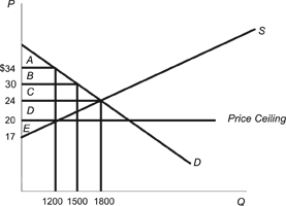Figure: Random Allocation under Price Ceilings 
Refer to the figure. The government enacted a price ceiling of $6 per unit. Using the information provided in the graph, calculate the following:
a. If the goods are allocated randomly between the high-value uses and the low-value uses, what is the total amount of consumer surplus in dollars?
b. What is the lost amount of consumer surplus when goods are allocated randomly, when compared to a situation in which the goods are allocated only to the highest-value uses?
Definitions:
Frivolous Lawsuits
Legal claims or cases that lack serious purpose or value, often brought with the intention of harassing or inconveniencing the defendant.
National Government
The organization responsible for governing a nation, typically composed of executive, legislative, and judicial branches.
Barron v. Baltimore
An 1833 United States Supreme Court case that held the Bill of Rights restricted only the federal government and not state governments, underscoring the federalism principle.
Nationalization
The process of transforming private assets into public assets by bringing them under the public ownership of a national government.
Q2: An item has a 8.2% markup based
Q15: (Figure: Supply and Demand 2) If the
Q42: Cost is equal to 100% when markup
Q103: A decrease in demand refers to:<br>A) a
Q138: Which of the following statements is TRUE?<br>A)
Q158: An increase in the price of corn
Q194: (Table: Sweetbrand Cheesecakes) The table shows the
Q239: Consumers who traded in a used car
Q254: Which of the following events will cause
Q321: (Figure: Effects of Price Ceilings) Refer to